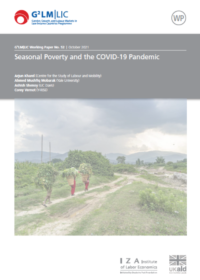Publications
Seasonal Poverty and the COVID-19 Pandemic
Poor populations in low-income countries are likely to suffer the worst of the economic fallout from the COVID-19 crisis. 75% of the world’s poor reside in rural agrarian areas where livelihoods fluctuate with the seasonal crop cycle. We investigate how seasonality mediates economic impacts of the crisis by constructing panel data to track rural Bangladeshi and Nepali households before and after the onset of the pandemic. We report how economic need may diverge from local infection risk in three key ways. First, current declines in employment and food security foreshadow even greater deprivation during the traditional agricultural lean season. Second, distress during harvest periods displaces agricultural and labor investment and will depress future earnings capacity. Third, nutritional and mental health deficits induced by the crisis can hinder economic decision-making and child development over the long term. Our findings inform how to target resources to facilitate economic recovery in rural areas.

